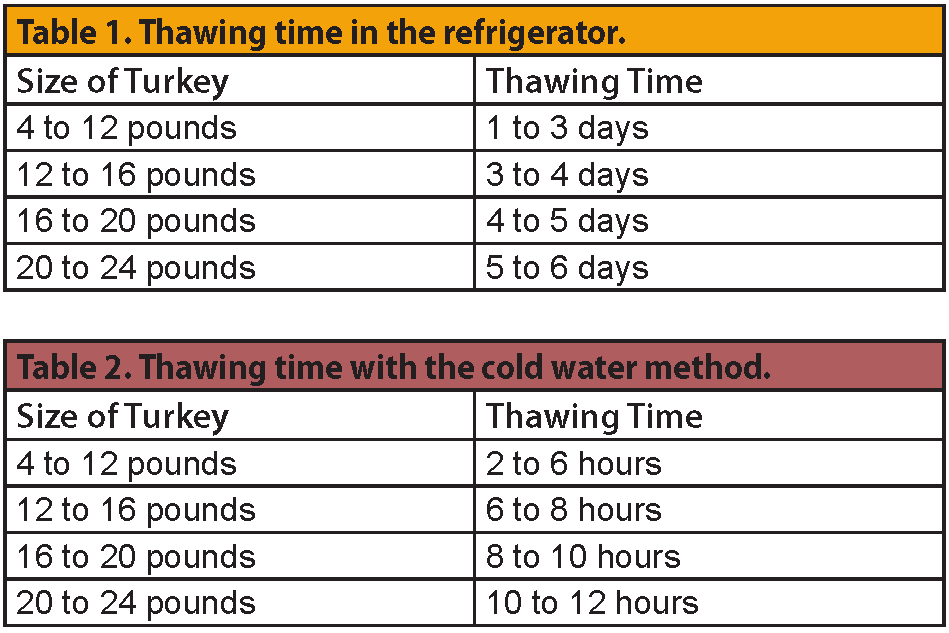Talking Turkey: Prep and Safety
Heather Norman-Burgdolf, Dietetics and Human Nutrition, and Annhall Norris, Family and Consumer Sciences
For many, Thanksgiving dinner is the largest meal prepared all year. So much time and effort go into planning the meal. There are decorations, place settings, the side dishes, the guest list, and the turkey! It’s easy to see how one could feel overwhelmed with preparing the turkey with so many other things to think about.
Turkey Nutrition
Holiday meals are typically known for their over indulgent foods; however, turkey remains a nutritious holiday staple. Turkey is low-fat, high in protein, and rich in iron, zinc, and several B Vitamins. A typical serving of turkey is 3 to 3½ ounces, about the size of a full, stacked deck of cards. A 3-ounce serving of boneless, skinless turkey breast meat has only 161 calories, 29g of protein, and 4g of fat. Similarly, a 3-ounce serving of dark thigh meat without skin is 192 calories, 28g of protein, and 8g of fat.
Purchasing a Turkey
Turkeys may be purchased either fresh or frozen. Neither is better than the other. When purchasing a turkey, plan for 1 pound per person. Free range or organic turkeys may be available at your grocery store. Free-range turkeys are raised in environments with more space, but this does not mean that they are organic. Organic turkeys must meet specific standards set forth by the The United States Department of Agriculture (USDA). Organic does not mean the turkey is free range. The nutrition of these turkeys is no different than a conventional turkey but may be two to four times more expensive. It is personal preference on which turkey meets your personal, ethical, and economical needs. A fresh turkey should be purchased no more than two days prior to the day of preparation. Check the “sell by” or “use by” date to make sure that the turkey is fresh. If a fresh turkey is desired for Thanksgiving Day, it may be best to call the local grocer to ensure a fresh bird will be available. Frozen turkeys may be purchased weeks, even months, in advance depending on available freezer space. With frozen turkeys, allow adequate time for the thawing process.
Thawing Methods
Turkeys must be kept at a safe temperature during the thawing process. They should never be left out at room temperature on the counter, in the basement, or outside on a cool day. It is not acceptable to thaw a turkey in the dishwasher, using a blow dryer, a brown paper bag, or any place where the temperature is above 40°F. When a frozen turkey begins to thaw, any bacteria that may have been present on the meat before freezing will begin to grow. If the meat stays in the “Danger Zone,” between 40°F140°F, for more than two hours, bacteria can grow rapidly. The USDA recommends three ways to safely thaw food containing turkey: in the refrigerator, in the sink using the cold water method, or in the microwave.
Thawing in the Refrigerator
When thawing a turkey in the refrigerator, make sure you allow enough time. You will need about 24 hours for each 4-5 pounds of turkey in a refrigerator set at 40°F. Place the bird in a large pan to collect any juices that may drip and contaminate other foods. Use Table 1 as a reference for thawing in the refrigerator. A turkey thawed in the refrigerator can remain in the refrigerator for 1-2 days before cooking. If necessary, the bird can be frozen again without cooking, but there will be some loss in quality.
Thawing with the Cold Water Method
The cold water method is simply thawing the turkey in a sink of cold water, where the water is changed every 30 minutes. Do not use warm or hot water with this method as this will put the turkey in the “danger zone” for longer than is recommended. You should allow about 30 minutes for each pound of turkey. Be sure to use cold water and make sure the bird is wrapped securely in a leak proof bag in order to prevent cross contamination and a watery bird. Use Table 2 as a reference for thawing in cold water. A turkey thawed using the cold water method must be cooked immediately.

Thawing in the Microwave
When thawing in the microwave, follow the microwave owner’s manual for defrosting a turkey. They should have recommendations for the cook level and time according to the size of the bird. Most microwaves cannot accommodate a turkey larger than 12 to 14 pounds. Plan on cooking the turkey immediately after thawing as some areas of the bird warm up quickly and begin to cook during the microwave thaw. Turkey should not be held for later cooking after thawing in the microwave as this increases the chance for bacterial growth. Thawing in the refrigerator is preferred. This the safest method because the temperature never rises above 40°F. Inside the refrigerator, the turkey thaws gradually at a consistent, safe temperature. Don’t worry if your turkey is still a little frozen before you cook it. The turkey is still safe to cook; it will just take longer. It’s even possible to cook a turkey that is still completely frozen. A turkey that is completely frozen will take 50 percent longer to cook than a turkey that has been thawed.
Getting Started
As the turkey thaws and you ready your space to prepare the turkey and other Thanksgiving dishes, keep the following food safety tips in mind.
· Before you start the cooking preparations, wash your hands with soap and warm water for 20 seconds.
· Don’t wash the turkey. This can spread bacteria onto kitchen surfaces. All raw meat contains bacteria. Washing the meat will not remove the bacteria. The only way to remove the bacteria is to cook the turkey properly.
· Keep the turkey away from all other foods during the thawing process and before cooking in order to avoid cross contamination.
· Don’t prepare any other foods until you have the turkey in the oven and have properly cleaned and sanitized the area.
· If possible, use a different cutting board and knife when preparing the turkey. Wash and sanitize everything that touched the raw meat, even countertops.
· Use a mild bleach solution made from 1 tablespoon unscented bleach per gallon of water to sanitize knives, cutting boards and work surfaces.
Turkey Leftovers
It’s never too early to start thinking about all of those wonderful turkey leftovers. Be sure to follow good food safety practices when preparing your turkey and storing it for those favorite recipes over the next several days.
Storing Leftovers
After dinner, don’t let food sit out on the table. Leftovers should be refrigerated or frozen within two hours. It is best to go ahead and remove all the meat from the turkey. Do not store stuffing inside the turkey. Remove the stuffing from the bird and refrigerate in a separate container. Legs and wings may be left whole, if desired. Sliced meat should be stored in shallow containers or small zipper bags and eaten within 3-4 days. If you aren’t sure the meat can be eaten in that time frame, it is best to freeze the leftover turkey. If the freezer stays below 0ºF, the turkey is safe to eat indefinitely. For best quality, sliced turkey stored in the freezer in freezer-safe zipper bags should be eaten within 6 months. Be sure to label leftovers going into the freezer with contents and the date on which they were frozen.

